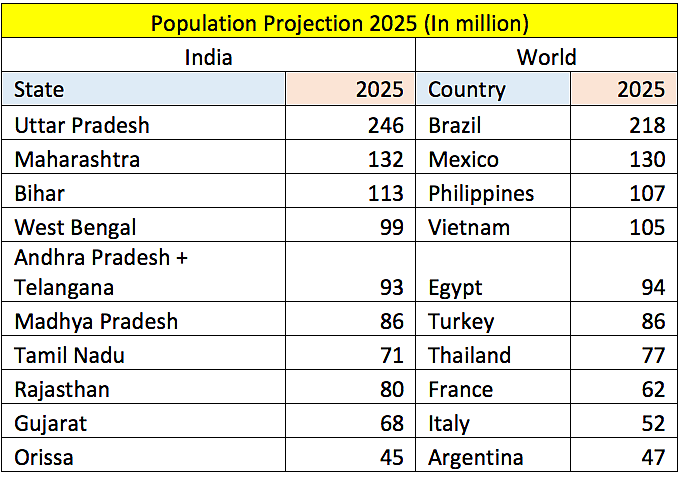With a total population of more than 1.2 billion people and growing, India’s population is set to stabilise—meaning, it will stop growing—by 2026.
For now, India is the second-most-populated country in the world and by these estimates, we will surpass China by 2050, when India’s population will be 1.5 billion and China’s 1.4 billion. Both countries are together home to 38% of the global population of 7 billion.
On World Population Day today, let us compare the population of the top 10 Indian states against select, mostly emerging-world countries—an easy matter, given the large populations of these states—and how their fertility rates will affect future growth.
Top 10 States of India and Comparable Countries

Both UP and Maharashtra presently have fewer people than the country counterparts we have chosen, Brazil and Mexico, but with present fertility rates, that will change within a decade.
What the Growth Rates Ordain
Here is how the population growth rates compare between Indian states and their country counterparts:

Total Fertility Rate (TFR) is a measure of population growth. The TFR of a population is the average number of children that a woman bears over her lifetime. India’s TFR today is 2.6 children per woman, less than half that of the 1950s, when it was 5.9, but it is still too high to stop population growth.
The TFR required to stabilise the population is 2.1 children per woman, which is called the replacement rate. The northern states hold the key. If India as a country has to reach 2.1, the northern states must reduce their TFR to two or lower. That does not seem immediately possible.
Over the Next Decade, India Will Speed up Before Slowing
Most of the emerging world will not grow as fast as India over the next decade.
India’s most populous states, the large northern states in particular, have high fertility rates, and that will keep India’s population growing.
So, UP will have more people than Brazil, Maharashtra more than Mexico, Gujarat more than Italy, Madhya Pradesh will catch up with Turkey.
However, states like West Bengal and Tamil Nadu with lower fertility rates, will have lower populations that their counterpart countries over the next 10 years. West Bengal now has more people than Vietnam, as does Tamil Nadu than Thailand, but by 2025, both states will have fewer people than Vietnam and Thailand respectively.

“The size of India’s future population will largely depend upon the course of fertility decline in the highly populous north,” said this study from the Population Reference Bureau. “While clearly in the third phase of the transition, will India move to the fourth phase of replacement fertility or will it join that group of developing countries where that seems doubtful? For the fourth phase to begin, fertility in the very large and poor Indian states will have to decline to that of an industrialized country, around two or fewer children.”
(At The Quint, we are answerable only to our audience. Play an active role in shaping our journalism by becoming a member. Because the truth is worth it.)
